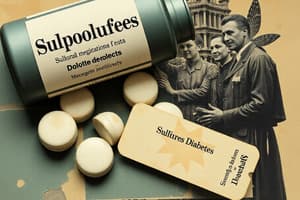Podcast
Questions and Answers
A client with type 2 diabetes is prescribed a sulfonylurea medication. What is the primary mechanism of action of this drug?
A client with type 2 diabetes is prescribed a sulfonylurea medication. What is the primary mechanism of action of this drug?
- Inhibiting glucose absorption in the intestine.
- Stimulating the beta cells of the pancreas to release more insulin. (correct)
- Decreasing glucose production in the liver.
- Enhancing the sensitivity of peripheral tissues to insulin.
A nurse is teaching a client about potential adverse effects of sulfonylureas. Which of the following should the nurse emphasize as the MOST significant risk?
A nurse is teaching a client about potential adverse effects of sulfonylureas. Which of the following should the nurse emphasize as the MOST significant risk?
- Hyperglycemia
- Hypertension
- Weight loss
- Hypoglycemia (correct)
Which instruction is most important for a nurse to provide to a client who is newly prescribed glyburide?
Which instruction is most important for a nurse to provide to a client who is newly prescribed glyburide?
- Take the medication on an empty stomach to maximize absorption.
- Monitor for signs and symptoms of hyperglycemia.
- Consume a consistent amount of carbohydrates at each meal. (correct)
- Increase alcohol intake to improve glycemic control
Why is it recommended to discontinue metformin before a CT scan with iodinated contrast?
Why is it recommended to discontinue metformin before a CT scan with iodinated contrast?
A client taking metformin reports experiencing nausea and diarrhea. What is the MOST appropriate initial nursing intervention?
A client taking metformin reports experiencing nausea and diarrhea. What is the MOST appropriate initial nursing intervention?
Metformin is classified as an "insulin sensitizer." What effect does this medication have on the body's response to insulin?
Metformin is classified as an "insulin sensitizer." What effect does this medication have on the body's response to insulin?
A patient taking metformin should be educated to monitor for which of the following symptoms indicative of lactic acidosis?
A patient taking metformin should be educated to monitor for which of the following symptoms indicative of lactic acidosis?
Which of the following clients is at the HIGHEST risk for developing lactic acidosis while taking metformin?
Which of the following clients is at the HIGHEST risk for developing lactic acidosis while taking metformin?
What is the primary mechanism of action of dipeptidyl peptidase-4 (DPP-4) inhibitors in managing type 2 diabetes?
What is the primary mechanism of action of dipeptidyl peptidase-4 (DPP-4) inhibitors in managing type 2 diabetes?
A client taking a sulfonylurea reports experiencing frequent episodes of hypoglycemia, particularly after exercise. Which of the following adjustments to their treatment plan might be MOST appropriate?
A client taking a sulfonylurea reports experiencing frequent episodes of hypoglycemia, particularly after exercise. Which of the following adjustments to their treatment plan might be MOST appropriate?
A patient on a '-gliptin' medication reports persistent, severe abdominal pain. What is the most appropriate nursing action?
A patient on a '-gliptin' medication reports persistent, severe abdominal pain. What is the most appropriate nursing action?
Which of the medications that are listed are indicated only for Type 2 diabetes?
Which of the medications that are listed are indicated only for Type 2 diabetes?
Which of the following adverse effects is associated with DPP-4 inhibitors and requires immediate discontinuation of the medication?
Which of the following adverse effects is associated with DPP-4 inhibitors and requires immediate discontinuation of the medication?
A patient with a history of heavy alcohol use and renal insufficiency is prescribed metformin. What is the MOST critical concern the nurse should address?
A patient with a history of heavy alcohol use and renal insufficiency is prescribed metformin. What is the MOST critical concern the nurse should address?
A client who has been taking metformin for an extended period reports symptoms of fatigue and numbness in their extremities. Which of the following vitamin deficiencies should the nurse suspect?
A client who has been taking metformin for an extended period reports symptoms of fatigue and numbness in their extremities. Which of the following vitamin deficiencies should the nurse suspect?
Incretin hormones, whose actions are enhanced by DPP-4 inhibitors, are produced in response to an influx of which nutrient?
Incretin hormones, whose actions are enhanced by DPP-4 inhibitors, are produced in response to an influx of which nutrient?
Flashcards
Sulfonylureas
Sulfonylureas
Medications that stimulate beta cells to release more insulin, effective for postprandial glucose levels.
Insulin
Insulin
Moves glucose from the blood into cells for energy or storage (as glycogen or fat).
Insulin Resistance
Insulin Resistance
Target cells become less responsive to insulin's signal.
Glycogen
Glycogen
Signup and view all the flashcards
Glucagon
Glucagon
Signup and view all the flashcards
Biguanides (Metformin)
Biguanides (Metformin)
Signup and view all the flashcards
Lactic Acidosis
Lactic Acidosis
Signup and view all the flashcards
Hypoglycemia (Sulfonylureas)
Hypoglycemia (Sulfonylureas)
Signup and view all the flashcards
Metformin and Lactic Acidosis
Metformin and Lactic Acidosis
Signup and view all the flashcards
Incretin Hormones
Incretin Hormones
Signup and view all the flashcards
DPP-4 Inhibitors
DPP-4 Inhibitors
Signup and view all the flashcards
Pancreatitis and Gliptins
Pancreatitis and Gliptins
Signup and view all the flashcards
DPP-4 Inhibitors and Arthralgia
DPP-4 Inhibitors and Arthralgia
Signup and view all the flashcards
Gliptins and Angioedema
Gliptins and Angioedema
Signup and view all the flashcards
Insulin's Function
Insulin's Function
Signup and view all the flashcards
Exogenous Insulin
Exogenous Insulin
Signup and view all the flashcards
Study Notes
- Sulfonylureas are indicated for only type 2 diabetes
- Insulin, produced by beta pancreas cells, helps move glucose from the blood to enter cells for energy.
- Excess glucose is stored in liver cells as glycogen or fat, while low blood glucose triggers glucagon release.
- Glucagon releases glucose from the liver into the blood, raising glucose levels.
- Insulin resistance occurs when receptors on target cells are less responsive to insulin signaling.
- Sulfonylureas directly stimulate beta cells to increase insulin release, which helps with insulin deficiency and insulin resistance causing hyperglycemia.
- These drugs are effective at lowering glucose after meals but continue increasing insulin regardless of blood glucose levels.
Medications
- Glyburide
- Glimepiride
- Glipizide
Adverse Effects
- High risk of hypoglycemia
- Weight gain occurs as excess glucose is moved into fat cells.
- Allergic reactions can occur in clients with sulfa allergies
Nursing Intervention
-
Check for sulfa allergies
-
Recognize symptoms of hypoglycemia
-
Give this medication with food to decrease risk of hypoglycemia
-
Decrease alcohol intake, to further lower risk of hypoglycemia
-
Encourage daily exercise and healthy dietary modifications
-
Biguanides, such as Metformin, are for type 2 diabetes and act as "insulin sensitizers."
Action
- Limit glucose entry into the bloodstream by decreasing glucose production in the liver.
- Reduce glucose absorption in the gut
- Sensitize insulin receptors in tissues to increase glucose uptake and utilization, without stimulating the pancreas to release insulin
Adverse Effects
- Nausea, vomiting, and diarrhea are common but transient, and typically subside when taken continuously.
- Slow dose titration is recommended to minimize these effects.
- Lactic acidosis is a life-threatening risk.
- High doses or accumulation can lead to increased production and decreased elimination of lactate, potentially causing metabolic acidosis.
- Use with caution in patients with renal insufficiency
- Co-administration with alcohol or iodinated contrast may lead to lactic acidosis
- Chronic use may interfere with vitamin B12 absorption, causing deficiency.
- Metformin is not associated with weight gain and has a low risk of hyoglycemia.
Client Teaching
-
Can be taken without food but it is still recommended to take with food
-
Decrease alcohol intake
-
Discontinue metformin 24-48 hours before CT scans with iodinated contrast dye
-
Monitor for lactic acidosis symptoms like malaise, myalgia, and tachypnea
-
Maintain a healthy lifestyle and diet.
-
Incretin hormones are produced in the small intestine in response to glucose influx, increasing glucose-dependent insulin release and decreasing glucagon release to lower blood glucose levels
-
Dipeptidyl Peptidase 4 Inhibitors stop the DPP4 enzyme from breaking down incretin hormones, enhancing glucose-lowering effects
-Gliptins (Dipeptidyl Peptidase 4 Inhibitors)
- Alogliptin
- Linagliptin
- Saxagliptin
Adverse Effects
- Acute or chronic pancreatitis is associated with stimulation of the pancreas by incretin hormones, so use cautiously in clients with risk factors for pancreatitis or obesity
- Arthralgia (joint pain) may occur from days to years after starting the drug and may resolve when discontinued
- Severe allergic reactions such as angioedema can occur due to inhibition of the breakdown of proteins that increase vascular permeability.
- Dermatological reactions such as bullous pemphigoid (itchy rash with large blisters) are possible
- Severe cutaneous reactions such as Steven Johnson's Syndrome can occur, resembling a burn
Client Teaching
-
Report abdominal pain, nausea, and vomiting immediately
-
Insulin replaces or supplements endogenous insulin, facilitating glucose entry into cells
-
Exogenous insulin mimics the body's natural insulin production using different types, categorized by onset of action
Types of Insulin
- Premeal Short duration insulins:
- Rapid-acting (Lispro, aspart, glulisine) is used for postprandial hyperglycemia
- Short-acting (regular insulin) is given IV for DKA
- Intermediate-acting:
- NPH (2x daily)
- Long-acting:
- Glargine, detemir, degludec
- Premixed:
- Intermediate + either short or rapid acting, reduces the number of injections
Sliding Scale of Insulin
- A sample problem involves administering NPH twice daily, with 12 units at bedtime, and regular insulin SubQ at 8:30 pm based on a sliding scale.
- Fingerstick glucose check: 171 mg/dL
- Insulin NPH 12 units + 3 units regular insulin by sliding scale = 15 units of insulin.
- To draw, withdraw 3 units of clear insulin followed by 12 units of cloudy NPH into the syringe.
Studying That Suits You
Use AI to generate personalized quizzes and flashcards to suit your learning preferences.



